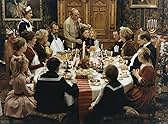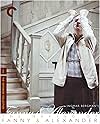ÉVALUATION IMDb
7,5/10
1,1 k
MA NOTE
Ajouter une intrigue dans votre langueA chronicle of the making of Ingmar Bergman's Oscar winning film.A chronicle of the making of Ingmar Bergman's Oscar winning film.A chronicle of the making of Ingmar Bergman's Oscar winning film.
Avis en vedette
10iF....
This is a documentary to see if you are interested in how movies are made. Seeing the master filmmaker Ingmar Bergman direct his last movie was so sentimental yet sad. During certain scenes he was directing, you could see REAL drama in the actor's faces whenever they tried their best to impress Bergman. You could see a sense of humanity and the close relationship between the people on set. See this film, you won't be disappointed.
Making of Fanny and Alexander, The (1986)
**** (out of 4)
Four years after Fanny and Alexander was released, director Bergman released this documentary that gives us a behind the scenes look at how the legendary master put together his (at the time) last masterpiece. I think this documentary could rank right up there with Bergman's greatest pictures because it features a lot of the stuff that his movies are so well known for. Watching how Bergman films certain scenes, like the pillow fight, where he goes back and forth on what he wants. In this scene he's debating whether the children should be wearing slippers or not. He decides they shouldn't be but then he worried about one of the kids slipping and hurting themselves. We also get to see more difficult scenes like the dying scene in the movie where he must direct twelve of the actors for a very hard shot. What's even more special are the scenes where Bergman is taking it easy and just chatting with the cast and crew. It's also great fun watching the master discuss shots with (the other master) Sven Nkvist. You can see how hard working both men are and it's rather amazing that neither killed the other. If you're a fan of Fanny and Alexander than this is a must see. If you're simply interested in how movies are made then this is one of the best documentaries out there.
**** (out of 4)
Four years after Fanny and Alexander was released, director Bergman released this documentary that gives us a behind the scenes look at how the legendary master put together his (at the time) last masterpiece. I think this documentary could rank right up there with Bergman's greatest pictures because it features a lot of the stuff that his movies are so well known for. Watching how Bergman films certain scenes, like the pillow fight, where he goes back and forth on what he wants. In this scene he's debating whether the children should be wearing slippers or not. He decides they shouldn't be but then he worried about one of the kids slipping and hurting themselves. We also get to see more difficult scenes like the dying scene in the movie where he must direct twelve of the actors for a very hard shot. What's even more special are the scenes where Bergman is taking it easy and just chatting with the cast and crew. It's also great fun watching the master discuss shots with (the other master) Sven Nkvist. You can see how hard working both men are and it's rather amazing that neither killed the other. If you're a fan of Fanny and Alexander than this is a must see. If you're simply interested in how movies are made then this is one of the best documentaries out there.
This is a film about a film. About, perhaps, the most outstanding film ever made. Bergman exudes his directorial artistry not being completely aware of it. He is at work, doing his thing, perfectly concentrated on the film this film is about.
The camera doing the second work -that is, Bergman's work, is unobtrusive, delicate and tells a completely different story. That may be the strongest point of all this. This film tells the story of how Bergman made the film of his life, his masterpiece. It's not technical. It's not flashy, nor spectacular. It's just the real story of how things worked throughout this extremely complicated and dark story: Bergman's life seen through the eyes of Alexander.
Here we find how Ingmar directed his actors. How he related to his friend and lifelong Director of Photography, Sven Nyvqyst. How he could leave things to others with complete confidence on their competence. How Nyvqyst used lighting, and how
decisions were made through the completion of a huge, long and demanding film.
If you are a film fan, even if you don't know Bergman, you'll find out why European cinema is much more elaborate in its story telling than the typical American film. This is not a director who wants to be on Time's cover. This is the story of how one man who loved theatre as well as film, who was himself an actor, who understood the deep emotions he wanted the audience to submerge in, did a work of art over, maybe, any other in the history of film making. I know this may sound quite cliche. If you can, try to find the five-hour DVD edition of the film, and then watch this one. You will never forget the experience.
One thing must be clear: if you are the "American Dream" kind of film fan, forget about even trying to feel comfortable with Bergman's films. They are overtly awkward compared with the straightforwardness of the typical american storytelling.
If you want more on Bergman, find his interview with a Swedish TV interviewer, talking about life, death and love. A one-hour feast, packed with the Criterion Collection's edition of Cries & Whispers. Worth every penny, too.
The camera doing the second work -that is, Bergman's work, is unobtrusive, delicate and tells a completely different story. That may be the strongest point of all this. This film tells the story of how Bergman made the film of his life, his masterpiece. It's not technical. It's not flashy, nor spectacular. It's just the real story of how things worked throughout this extremely complicated and dark story: Bergman's life seen through the eyes of Alexander.
Here we find how Ingmar directed his actors. How he related to his friend and lifelong Director of Photography, Sven Nyvqyst. How he could leave things to others with complete confidence on their competence. How Nyvqyst used lighting, and how
decisions were made through the completion of a huge, long and demanding film.
If you are a film fan, even if you don't know Bergman, you'll find out why European cinema is much more elaborate in its story telling than the typical American film. This is not a director who wants to be on Time's cover. This is the story of how one man who loved theatre as well as film, who was himself an actor, who understood the deep emotions he wanted the audience to submerge in, did a work of art over, maybe, any other in the history of film making. I know this may sound quite cliche. If you can, try to find the five-hour DVD edition of the film, and then watch this one. You will never forget the experience.
One thing must be clear: if you are the "American Dream" kind of film fan, forget about even trying to feel comfortable with Bergman's films. They are overtly awkward compared with the straightforwardness of the typical american storytelling.
If you want more on Bergman, find his interview with a Swedish TV interviewer, talking about life, death and love. A one-hour feast, packed with the Criterion Collection's edition of Cries & Whispers. Worth every penny, too.
The next best thing to watching Bergman's films is for me to watch and listen to him talking about himself and about his works. "Making of" is a fascinating document - I always wanted to know how he makes his films, what is behind the poetry of images and the sound of silence. Following the master's steps, watching the most magical scenes born in front of you, seeing him in control of his production, always knowing what he wants and leading his crew and his actors; his longtime friendship with his legendary cinematographer Swen Nykwist to the point that they don't talk much - they don't need many words to understand each other - all of these made "Making of Fanny and Alexander" absolutely unique and amazing experience for me. The birth of each scene is a miracle but some of them stand out. The first is one of the most enigmatic and magical scenes ever and not only in Bergman's films - night scene in the Isak's house between Alexander and Ismael, a completely mysterious character with supernatural psychic powers who helped Alexander to unleash his own powers he never knew he had.
The second is the scene with Gunnar Björnstrand, one of the most versatile Bergman's actors (Höstsonaten, (1978), Ansikte mot ansikte (1976), Skammen (1968), Persona (1966), Nattvardsgästerna (1963), Såsom i en spegel (1961), Ansiktet (1958), Smultronstället (1957), Sommarnattens leende (1955), and his masterpiece Det Sjunde inseglet, (1957)). He was old and apparently ill while making Fanny and Alexander which was his last film. The scene in "Making of..." is almost 20 minutes long and shows over and over how Bergman rehearses a short, perhaps one or two minute long cameo with Björnstrand as clown Feste in Shakespeare's "Twelfth Night". It is painful to watch a great actor in such a pitiful state. At some point you'd want Bergman to stop what seems like a torture but he goes on, encouraging his friend, praising him, making sure that Gunnar feels comfortable but not stopping before the scene is shot to his liking...
The second is the scene with Gunnar Björnstrand, one of the most versatile Bergman's actors (Höstsonaten, (1978), Ansikte mot ansikte (1976), Skammen (1968), Persona (1966), Nattvardsgästerna (1963), Såsom i en spegel (1961), Ansiktet (1958), Smultronstället (1957), Sommarnattens leende (1955), and his masterpiece Det Sjunde inseglet, (1957)). He was old and apparently ill while making Fanny and Alexander which was his last film. The scene in "Making of..." is almost 20 minutes long and shows over and over how Bergman rehearses a short, perhaps one or two minute long cameo with Björnstrand as clown Feste in Shakespeare's "Twelfth Night". It is painful to watch a great actor in such a pitiful state. At some point you'd want Bergman to stop what seems like a torture but he goes on, encouraging his friend, praising him, making sure that Gunnar feels comfortable but not stopping before the scene is shot to his liking...
Aspiring directors -- even if it's only family movies with a camcorder they plan to make -- should see this documentary on how the master film maker created magic. Bergman knew what he wanted before he planned each scene. So have many other directors. And some of the actors who worked with some of these other directors never made another film again. Bergman got his favorite actors to come back film after film, because he knew how to get them to do takes over and over again without destroying their egos. His work with the two children is especially touching. "My sister and I giggled like that," he told the youngsters playing Fanny and Alexander.
Le saviez-vous
- AnecdotesThis film is part of the Criterion Collection, spine #264.
- ConnexionsEdited from Fanny et Alexandre (1982)
Meilleurs choix
Connectez-vous pour évaluer et surveiller les recommandations personnalisées
Détails
Contribuer à cette page
Suggérer une modification ou ajouter du contenu manquant

Lacune principale
By what name was Dokument Fanny och Alexander (1984) officially released in India in English?
Répondre






















